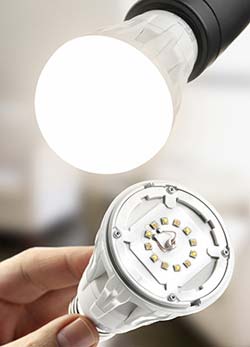LED Concept for Efficient, Warm-white Light

Until now, it was almost impossible to achieve high efficiency with a warm-white LED light similar to that of an incandescent lamp, because the warmer the white light was, the lower the luminous efficiency became.
And energy efficiency dropped even lower if you also wanted to have very good color rendering properties. Now there’s ‘Brilliant Mix’, a special combination of white and red LEDs that boosts the efficiency of warm-white LED lamps by almost one-third. What’s more, the LED light’s color rendering value of over 90 even surpasses that of energy-saving bulbs.
These LEDs would be particularly attractive for department and clothing stores, where customers need to judge colors and should feel comfortable. A white LED usually consists of a blue-glowing chip coated with a layer of phosphor. Excited by the blue light, the phosphor layer glows yellow. The superimposition of the two colors appears as a cold shade of white to viewers. Warm shades of white are created with the help of reddish converters, which, however, absorb light. Because most LED lamps consist of several light-emitting diodes, the ‘Brilliant Mix’ concept combines very efficient white LEDs using a special type of phosphor with red LEDs.
This creates a warm-white light with an efficiency of over 100 lumens per watt (lm/W). An energy-saving bulb has a luminous efficiency of about 60 lm/W. The new concept achieves high efficiency with the help of improved chip technology, a more efficient converter material, and other factors.
A light source’s color rendering properties are dependent on its frequency spectrum — only colors that are emitted are also reflected. LEDs using the Brilliant Mix concept emit light over a broad spectrum, which is why they have very good color rendering properties. ‘Brilliant Mix’ even achieves a color rendering index value of 98 for the especially critical flesh tones. This result is almost identical to the reference value for daylight, which is 100. The ratio of red to white LEDs makes it possible to create light with a color temperature of 2,700 to 4,000 Kelvin (the former value corresponds to that of an incandescent lamp).
Osram Opto Semiconductors is a subsidiary of Osram, which is owned by Siemens. Highly efficient LED lighting forms part of the Siemens Environmental Portfolio, which generated around €28 billion in sales for the company in fiscal year 2010.
Media Contact
More Information:
http://www.siemens.com/innovationnewsAll latest news from the category: Power and Electrical Engineering
This topic covers issues related to energy generation, conversion, transportation and consumption and how the industry is addressing the challenge of energy efficiency in general.
innovations-report provides in-depth and informative reports and articles on subjects ranging from wind energy, fuel cell technology, solar energy, geothermal energy, petroleum, gas, nuclear engineering, alternative energy and energy efficiency to fusion, hydrogen and superconductor technologies.
Newest articles

A universal framework for spatial biology
SpatialData is a freely accessible tool to unify and integrate data from different omics technologies accounting for spatial information, which can provide holistic insights into health and disease. Biological processes…

How complex biological processes arise
A $20 million grant from the U.S. National Science Foundation (NSF) will support the establishment and operation of the National Synthesis Center for Emergence in the Molecular and Cellular Sciences (NCEMS) at…

Airborne single-photon lidar system achieves high-resolution 3D imaging
Compact, low-power system opens doors for photon-efficient drone and satellite-based environmental monitoring and mapping. Researchers have developed a compact and lightweight single-photon airborne lidar system that can acquire high-resolution 3D…





















